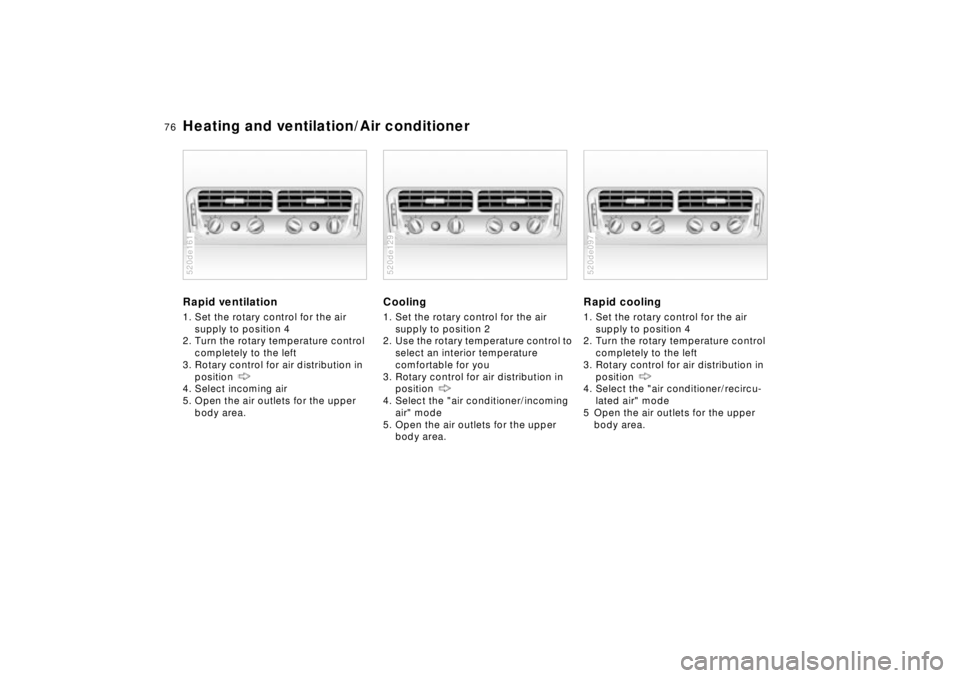cooling BMW Z8 CONVERTIBLE 2002 Owners Manual
[x] Cancel search | Manufacturer: BMW, Model Year: 2002, Model line: Z8 CONVERTIBLE, Model: BMW Z8 CONVERTIBLE 2002Pages: 174, PDF Size: 2.37 MB
Page 76 of 174

76n
Heating and ventilation/Air conditionerRapid ventilation1. Set the rotary control for the air
supply to position 4
2. Turn the rotary temperature control
completely to the left
3. Rotary control for air distribution in
position
4. Select incoming air
5. Open the air outlets for the upper
body area.520de161
Cooling1. Set the rotary control for the air
supply to position 2
2. Use the rotary temperature control to
select an interior temperature
comfortable for you
3. Rotary control for air distribution in
position
4. Select the "air conditioner/incoming
air" mode
5. Open the air outlets for the upper
body area. 520de129
Rapid cooling1. Set the rotary control for the air
supply to position 4
2. Turn the rotary temperature control
completely to the left
3. Rotary control for air distribution in
position
4. Select the "air conditioner/recircu-
lated air" mode
5 Open the air outlets for the upper
body area.520de097
Page 91 of 174

91n
IndexDataTechnologyRepairsCar careControlsOverview
Disc brakesDriving notesWhen driving in heavy rain and on wet
roads it is advisable to apply light pres-
sure to the brake pedal every few miles.
Monitor traffic conditions to ensure that
this maneuver does not pose a hazard
to you or to other road users. The heat
generated in this braking process helps
dry the pads and rotors
Maximum braking force is obtained
while the wheels are not locked, but
rather when they are still barely turning
immediately prior to locking. ABS main-
tains this state automatically. If the ABS
fails, you should revert to the staggered
braking technique (refer to page 93).
When descending steep hills and
extended grades, downshift to a gear
that will allow you to continue safely
with only a minimal amount of braking.
By minimizing the loads placed on the
brake system, this strategy helps
ensure that optimal brake system
response will remain available at all
times.
You can enhance the engine's braking
effect by downshifting, into first gear, if
necessary. Even if engine braking fails to slow the
vehicle sufficiently, you should still
make every effort to avoid prolonged
braking with continuous application of
low to moderate pressure at the pedal.
It is better to decelerate the vehicle by
applying a higher level of force at the
pedal (watch following traffic!) and then
subsequently pausing to allow the
brakes to cool briefly before starting on
your next braking cycle. By protecting
brake system components against
overheating, the cooling phases
afforded by this staggered, or intermit-
tent braking technique help maintain
consistent availability of optimal braking
response when it is needed.
Do not coast with the clutch pedal
depressed, the gear-shift lever in
neutral, or, above all, with the engine
off; otherwise, the engine will provide
no braking effect if the transmission is
in neutral, and there is no braking or
steering power assist if the engine is
not running. Never allow floor mats,
carpets or any other objects to obstruct
the accelerator, clutch or brake pedals
and pose a safety hazard by reducing
their available travel range.<
Page 161 of 174

161n
Index
Data
Technology
Repairs
Car care
Controls
Overview
Capacities
Notes
Fuel tank
Reserve gal. (liters)
gal. (liters)approx. 19.3 (approx. 73)
approx. 2.5 (approx. 10) Fuel quality: page
26
Windshield washer system/
Headlamp washer system quarts (liters) approx. 5.6 (approx 5.3) For details: page 110
Cooling system including heater
circuit quarts (liters) 12.7 (12.0) For details: page
113
Engine oil filter change quarts (liters) 7.9 (7.5) "BMW High Performance Synthetic Oil." For details: page 112
Manual transmission quarts (liters) 2.0 (1.9) Lifetime fluid; no fluid change required
Differential quarts (liters) 1.3 (1.2) Fluid change at the 1,200-mile-service, then lifetime
fluid; no fluid change required